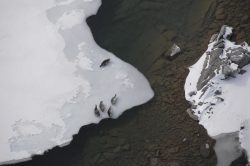
Hundreds of harbor seals live in Iliamna Lake, the largest body of freshwater in Alaska and one of the most productive systems for sockeye salmon in the Bristol Bay region.
These lake seals are a robust yet highly unusual and cryptic posse. Although how the seals first colonized the lake remains a mystery, it is thought that sometime in the distant past, a handful of harbor seals likely migrated from the ocean more than 50 miles (80 kilometers) upriver to the lake, where they eventually grew to a consistent group of about 400. These animals are important for Alaska Native subsistence hunting, and hold a top spot in the lake’s diverse food web.
Lifelong chemical records stored in their sequentially growing canine teeth show that the Iliamna Lake seals remain in freshwater their entire lives, relying on food sources produced in the lake to survive. In contrast, their relatives in the ocean are opportunistic feeders, moving around to the mouths of different rivers to find the most abundant food sources, which includes a diverse array of marine food items in addition to the adult salmon returning to Bristol Bay’s nine major watersheds. These findings are described in a paper published online in March in Conservation Biology.
“We clearly show these seals are in the lake year-round, throughout their entire lives,” said lead author Sean Brennan, a postdoctoral researcher at the University of Washington’s School of Aquatic and Fishery Sciences. “This gives us critical baseline information that can weigh in on how we understand their ecology, and we can use that information to do a better job developing a conservation strategy.”
Read more at UW News »
